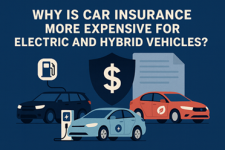Why Is Car Insurance More Expensive for Electric and Hybrid Vehicles? The Real Reasons Behind EV and PHEV Insurance Costs
Meta description: Learn why insurance for electric and hybrid vehicles often costs more than for gasoline cars especially in the USA and Canada. Real-world factors explained.
Introduction
Electric vehicles (EVs) and plug-in hybrids (PHEVs) are transforming the automotive market. They promise lower fuel costs, reduced emissions, and a smoother driving experience. Yet, one unpleasant surprise awaits many new EV owners higher insurance premiums.
In the United States and Canada, electric and hybrid vehicle insurance often costs 15–30% more than for comparable gasoline cars. But why? Let’s break down the real-world reasons behind these price differences and what drivers can do about them.
1. Higher Vehicle Value and Repair Costs
The main reason EV and PHEV insurance costs more is simple: the cars themselves are more expensive.
Electric vehicles use costly components, especially their large lithium-ion battery packs, advanced power electronics, and specialized sensors. A minor accident that damages the battery housing or high-voltage wiring can lead to repairs costing thousands of dollars even if the rest of the car is fine.
In many cases, insurers prefer to declare an EV a total loss rather than risk battery-related safety issues after an impact. This drives up average claim values, and thus premiums.
Example:
- A small fender-bender on a gas-powered SUV may cost $2,000 to repair.
- The same accident on an EV might cost $10,000 or more, because specialized technicians and parts are needed to inspect or replace the battery modules.
2. Battery Replacement and Fire Risk Concerns
While EV fires are statistically rarer than gasoline fires, they are more expensive and complex to handle. Fire departments need special procedures, and insurers must often replace the entire battery pack afterward even if damage is minimal.
Unfortunately, battery replacement costs are still opaque. Manufacturers rarely disclose precise replacement prices, and insurers have limited access to detailed repair data. In North America, replacement batteries can cost $10,000–$25,000, depending on the model.
This lack of transparency means insurers must assume worst-case scenarios when setting premiums pushing EV and hybrid insurance costs even higher.
3. Lack of Historical Data
Insurance is based on data, and for electric vehicles, long-term statistics are still limited. Gasoline cars have decades of detailed claim records, allowing insurers to calculate precise risk levels.
In contrast, EVs and PHEVs represent a relatively new market. There’s less data on:
- Accident frequency and severity,
- Battery degradation and failure rates,
- Repair costs after collisions,
- Theft rates and recovery success.
Without this information, many insurers err on the side of caution, adding a “risk buffer” to premiums.

4. Specialized Repair Networks and Labor Costs
Repairing an EV requires high-voltage certification, safety training, and special tools. Not every mechanic or body shop can legally or safely work on these vehicles.
In the U.S. and Canada, there are far fewer certified EV repair centers compared to gasoline car shops. This scarcity drives up labor prices, towing distances, and overall repair costs all of which are reflected in insurance premiums.
Key fact: According to several Canadian auto body associations, EV repairs can take 20–30% longer on average due to complex diagnostics and battery isolation procedures.
5. More Technology = More Sensors to Damage
Modern EVs and hybrids come with advanced driver-assistance systems (ADAS) radar sensors, cameras, ultrasonic detectors, and LiDAR units.
While these systems improve safety, they also increase repair bills. Even a cracked bumper may require recalibrating multiple sensors. In many EVs, such as the Tesla Model Y or Hyundai Ioniq 5, a single bumper replacement can cost $3,000–$5,000 due to sensor recalibration and alignment.
6. Regional Factors: USA and Canada
The United States and Canada face unique challenges that make EV insurance more expensive than in Europe or Asia:
- Climate: Cold temperatures affect range and battery health, increasing wear and potential warranty claims.
- Labor shortages: Fewer EV-qualified technicians mean higher hourly labor costs.
- Parts availability: North American EV repair parts often come from overseas, leading to longer repair times and rental car expenses.
- Regulatory differences: Each province or state sets its own insurance rules, leading to inconsistent pricing models.
Because of this, EV owners in Canada and northern U.S. states (like Minnesota or Michigan) often pay the highest premiums even more than owners of high-performance gasoline cars.
7. Hybrids and PHEVs: Caught in the Middle
Plug-in hybrids (PHEVs) and standard hybrids share some of the same issues as EVs, though to a lesser degree. Their dual powertrains (gas + electric) mean more parts to repair and more complex systems for technicians to diagnose.
However, since hybrids have smaller batteries and less high-voltage wiring, their insurance premiums typically fall between EVs and gasoline cars.
Average annual insurance comparison (U.S. 2024 estimates):
| Vehicle Type | Average Annual Premium (USD) |
|---|---|
| Gasoline (ICE) | $1,700 |
| Hybrid | $1,950 |
| Plug-in Hybrid (PHEV) | $2,100 |
| Fully Electric (EV) | $2,250 |
8. Are EV Insurance Costs Expected to Drop?
Yes gradually. As electric vehicles become more common, insurers will gather more reliable data on accident rates, repair costs, and long-term durability.
Automakers are also responding by:
- Designing modular battery packs that allow partial replacement,
- Expanding certified repair networks,
- Sharing more cost data with insurers, and
- Offering manufacturer-backed insurance (like Tesla and Rivian already do).
Experts predict that within 5–7 years, EV insurance premiums will become much closer to gasoline vehicle levels especially as used EV markets mature and more independent repair shops gain certification.
9. How to Lower Your EV or Hybrid Insurance Costs
If you already own or plan to buy an electric or hybrid vehicle, here are some practical steps to keep insurance affordable:
- Compare multiple quotes different insurers treat EVs very differently.
- Choose higher deductibles to lower premiums.
- Install home charging and telematics apps some insurers offer eco-driving discounts.
- Bundle policies (home, life, and auto) for loyalty savings.
- Ask about safety discounts many EVs qualify for reduced rates thanks to their advanced collision-avoidance systems.
- Avoid excessive modifications aftermarket changes can void coverage or raise rates.
Conclusion: Transparency Is the Key
The reason EV and hybrid insurance costs are higher isn’t simply “greedy insurers.” It’s a complex mix of limited repair data, high battery costs, and a young industry still finding its footing.
In North America, where cold weather, long distances, and repair costs are unique challenges, the issue is especially visible. Until insurers gain full transparency into battery replacement prices and repair economics, electric and hybrid vehicles will likely remain more expensive to insure than traditional gasoline cars.
The good news? As the EV ecosystem matures, competition and data will drive fairness and insurance for your electric car will one day be just as affordable as your old gas-powered one.
